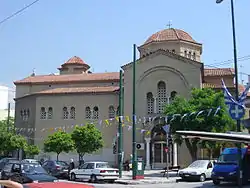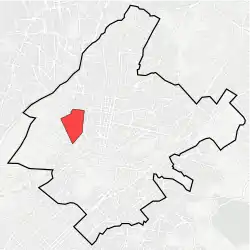Kolonos
Kolonos (Greek: Κολωνός, pronounced [ko.loˈnos]) is a densely populated working-class district of the Municipality of Athens. It is named after the ancient deme, Hippeios Colonus.
Kolonos
Κολωνός | |
|---|---|
Neighborhood | |
 | |
 Location within Athens | |
| Coordinates: 37°59′45″N 23°42′55″E | |
| Country | Greece |
| Region | Attica |
| City | Athens |
| Postal code | 104 44 |
| Area code(s) | 210 |
| Website | www.cityofathens.gr |
The district hosts a multi-year football club, Attikos F.C., that was founded in 1919.[1]
- Kolonos is a large, historic district located in the northwest of the Municipality of Athens. It borders the districts of Metaxourgio, Plato Academy, Skouze Hill, Kolokynthos, Sepolia and Attica, while its borders to the west reach Kifissos Avenue. It is crossed by Lenorman Street and is served by metro line 2 and Larissa station, but also by the electric railway and the Attica station.
- Kolonos is a densely populated area with minimal uncovered areas. Still it is a lively neighborhood full of traffic. It was heavily rebuilt mainly in the 1960s and 1970s. The hill of Ippio Kolonos (37 ° 59.7′N 23 ° 42.9′E) is part of the district.
- In ancient times, Kolonos was considered the most aristocratic municipality of ancient Athens. It was a riparian municipality and was crossed by the river Kifissos, which today has been undergrounded under Kifissos Avenue.
- HISTORY OF KOLONOS: Main entry: Kolonos Aigidia
Ippios (or Ippios) Kolonos was located in the plain of Kifissos, 10 steps (2 km) north of Dipylos and was overgrown with olive trees. It was called "Equestrian", because there was the temple of Equestrian Poseidon, patron saint of the municipality, which was destroyed by Antigonus Gonatas in 265 BC. of Theseus, Peirithos and Adrastos. Here was the statue of Kolonos, who gave his name to the municipality.
- In recent years, the German archaeologist Ludwig Ross (1806 - 1859), who visited Athens in 1832-33, gives an eloquent description of Kolonos in his "Memories": Kolonos is a low hill in the distance from the city that Thucydides gives - 10 steps - with a nice unusual view, at sunset, to the city, the Acropolis, the whole beach of Cape Kollia, down to Piraeus and above from him, against the backdrop of the deep blue sea, Aegina and, in the background, the soft emerging coasts of Argolida.
- But the Grove of Poseidon and the Erinyes and their other sanctuaries that were here, as well as the village itself, have completely disappeared, except for a few ruins of foundations and the small hill. Christiane Lueth (1817 - 1900), a Dane who lived in Athens during Otto's years with her husband, the German theologian and philosopher Asmus Lyt, writes about the death of archaeologist Charles Müller, who is buried in hill of Kolonos: The great archaeologist Carl Otfried Müller died in Athens on August 2. He returned ill from a trip he had made with Ernest Curtius and Seller. Lyt buried him on the hill of Kolonos, where in the old days the temple of the Eumenides was located and near the Academy where Plato taught ... A beautiful marble monument was erected on the hill.
And the Danish writer Hans Christian Andersen, who visited Kolonos on a trip to Greece in 1841, describes his impressions of the natural environment of Kolonos:I was in Kolonos ... Here is buried the German K. O. Müller, who died a while ago and to whom science owes so much ... I leaned on the wet grave ... The mountain air was coming down cold and bitter .. There was a greatness in all nature, which even Switzerland cannot offer you.
Kolonos is the site of ancient Colonus, a deme of ancient Attica.[2][3]
References
- "Greece Team Colors". rsssf.com. Retrieved 15 April 2015.
- Lund University. Digital Atlas of the Roman Empire.
- Richard Talbert, ed. (2000). Barrington Atlas of the Greek and Roman World. Princeton University Press. p. 59, and directory notes accompanying.
This article is issued from Wikipedia. The text is licensed under Creative Commons - Attribution - Sharealike. Additional terms may apply for the media files.
